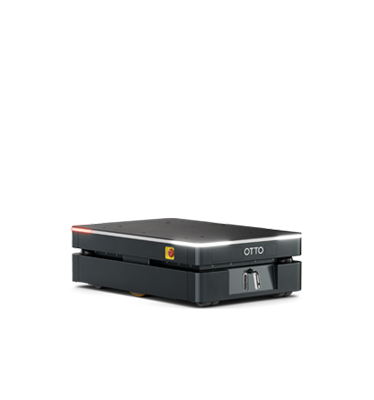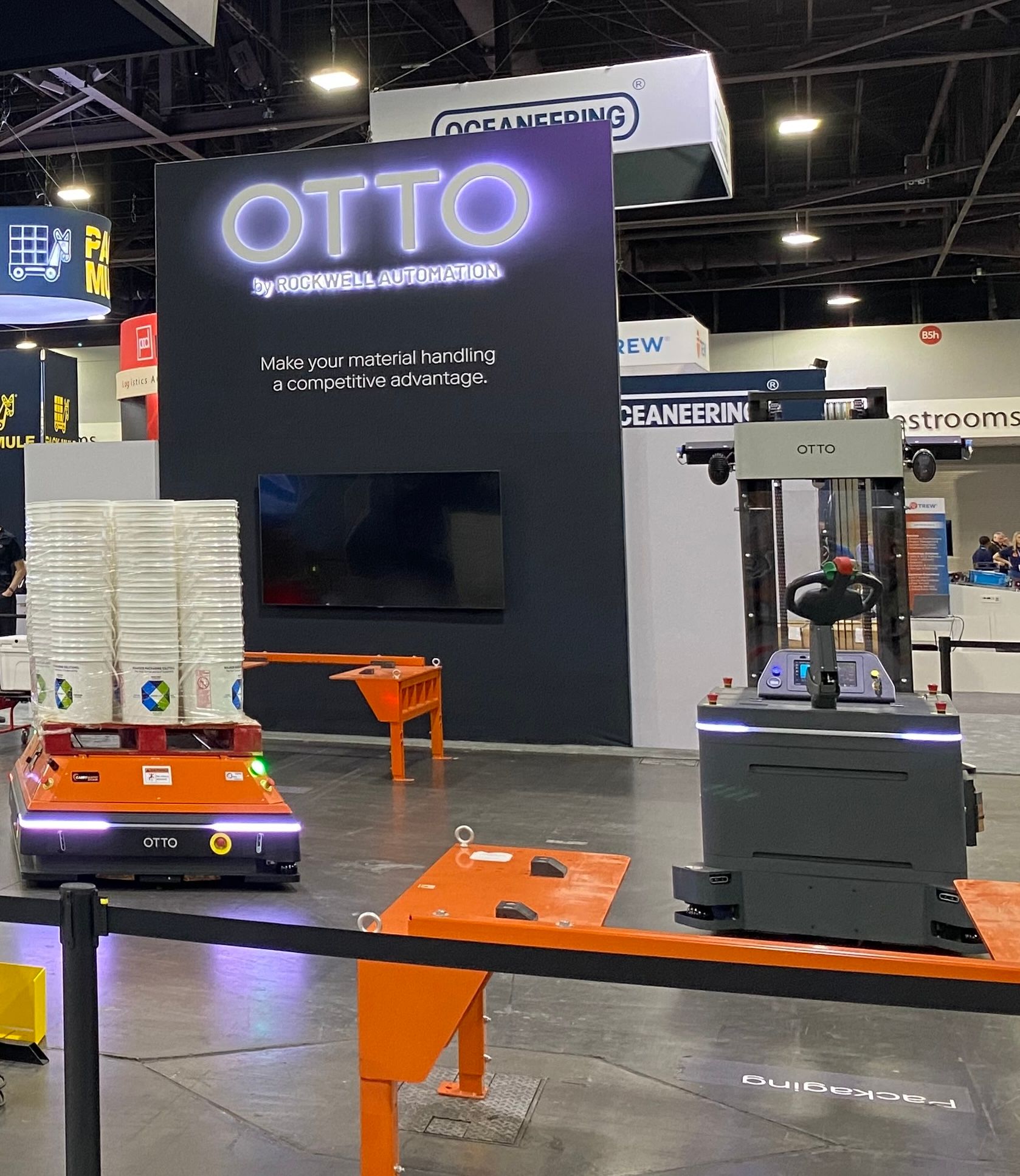Blog
Lessons learned in business-critical AMR installations

At the recent MODEX supply chain trade show, OTTO Motors’ CEO and Co-Founder Matt Rendall was joined by three automation experts on the front line of deploying AMR solutions.
Joining Matt, were:
- Ellen Brune, General Manager of Integrated Storage Solutions at Honeywell Intelligrated
- Scott Spaeth, Director of Corporate Automation at Berry Global
- Steven Weis, Manager of Advanced Automation at The Hershey Company
All three candidly shared what they learned in order to help those just starting their AMR journeys. Collectively, five practical first steps for AMR deployments emerged from the conversation.

From left, Matt Rendall, Steven Weis, Scott Spaeth, and Ellen Brune.
First, Weis, Spaeth, and Brune discussed the benefits they’ve seen with AMRs besides tangible labor reduction
Weis explained that when AMRs were first installed at The Hershey Company “the activities that folks need to do to get their jobs done on a day-to-day basis using conventional forklifts and stacks of pallets in an area, the way we’re applying labels, all of that changed within the hour. There was a standardization of process that took place where we had pallet movement cadence. We saw efficiencies that were, and still are, hard to measure.”
At Berry Global, AMRs enabled the removal of conveyors and elevators that presented significant injury risks to employees. Spaeth adds that AMRs also “just cleaned up the floor. AMRs have to have a good 5S environment, a very disciplined environment in order for them to be successful, and in some ways [their use] forces you into having that and also forces you to keep it that way, and I think that too has been a very big benefit in our situation. And just calming the operations down…forklift traffic or manned vehicle traffic or hand truck traffic, all of that noise just settled down.”
AMRs have also provided Berry Global a more reliable plant operation.
You're not really at the whim of someone not being able to come in that day and run that cell, so that removes an element of risk in being able to serve our customers.
Scott Spaeth
Director of Corporate Automation, Berry Global

OTTO 100 driving with a Berry Global payload.
A lot of times we’re using AMRs to just increase capacity or throughput of the building with no intention of reducing the labor force…the lead times on getting new roofs put up is huge, and with a lot of these AMR applications, just the ability to increase the capacity and throughput of the building that we already had is really the biggest benefit that we’re seeing.
Ellen Brune
General Manager of Integrated Storage Solutions, Honeywell Intelligrated
In Honeywell Intelligrated projects, AMRs have also reduced the amount of dull, dirty and dangerous work employees have to do, and enable the elevation of high-performing employees to robot management, a challenge which they really enjoy.
Watch OTTO 1500 running a demo in Honeywell’s booth.
Rendall then asked how AMR use has impacted the evolution of each company’s automation strategy over the last few years, and going forward
Spaeth explained “AMRs for us have been an area where we’ve really been able to take a much larger chunk of labor out, where we were driven to reduce labor at the end of those lines. And we had really come to the end of those roads, but AMRs have allowed us to bring product to a central location and then automate all of those non-value-added tasks out of the operation. That’s our strategy moving forward, to continue to work on those end-of-line operations; to use AMRs to take on more of those transformational-style projects.”
He added that “COVID really put us at the mercy of our employees and … a really difficult spot in parts of our business, and that’s part of our strategy going forward, looking at where we’ve got the most risk in terms of our workforce and applying automation to that.”
Brune observed that over the last few years, “we realized that robots and AMRs are pretty good at being people but they’re better at being AMRs.” That is, she and her colleagues had originally gone into the process of AMR implementation by asking how to take a task or a process that a person is doing and have a robot do it instead, but along the way they realized they needed to look at a task and ask how they could optimize it for AMR completion.
“It’s not always a nice one-to-one switch from one to the other,” she noted. “That was the biggest shift, and I’m seeing it across the market in general as I’m talking to more and more players.”
Lastly, Rendall asked for lessons learned, which those who are just starting their AMR journeys would be wise to fully absorb
1. Familiarize and prepare your workforce
Exposing employees to how AMRs will function before the robots arrive is critical to smooth adoption, according to Weis.
Get vehicles up early, get ‘Fleet Manager’ up early, just running in the area, not necessarily performing a task, just exposure. Put video of the guided robots on the kiosk in the lunchroom. And any training that you can provide, OTTO has an excellent training program, the OTTO Start program, is worth every dime spent. It will expose the operations folks, the maintenance folks, and/or the engineering types to all aspects of ownership and maintenance and deployment.
Steven Weis
Manager of Advanced Automation, The Hershey Company
Brune also stressed the need to articulate to employees the limitations of AMRs – what they can and cannot do. “They are good at being robots,” she says. “They assume that everyone is following the exact same rulebook that you gave it. [Employees need to understand that AMRs] will do exactly what they are programmed to do.”
2. Take a close look at IT infrastructure

Engineer setting up OTTO 100.
Spaeth stressed the need to involve your IT team early in the AMR adoption process. “It’s absolutely critical,” he said. “It’s one of the biggest pieces. It’s really the life of whether these systems run or don’t.”
“Whether you have the appropriate redundancies in place…a map of your wireless access points inside the cells, make sure you’ve got folks [who understand AMR system requirements] that are in the room when you’re having the AMR conversations,” he said. “We prepared our IT group with documentation, and said this is what we’re intending to do, and asked ‘Do you believe we have the network to support it?’ You need to make sure they are keenly engaged and make sure you’ve got the appropriate infrastructure in place for implementation.”
Brune shared, “we learned the hard way that our wireless communications bands can get very, very busy and we discovered the robots were trying to communicate with each other on the exact same frequency of some of our wireless printers and that caused some issues, so if you can bring in IT early they can do a band spectrum analysis.”
3. Involve operators and everyone else
“Deployments always went so much better when we had the operational staff involved in designing some of our process flows,” Brune said.
Spaeth added that “operators give you a lot of insight that you’re not able to pick up through their supervisors and managers, and I think moreover that the table for us got larger and larger when we looked at who we needed to involve – whether it was on safety or on quality, the warehouse folks, the operations folks. Every conversation we had around our projects was involving all of those."
4. Safety first
Brune stressed that it’s absolutely critical - whether it's part of the internal team or with your AMR partner - that somebody knows the safety standards inside and out.
“Somebody needs to be able to articulate what the bounds are, because again, it's not that nice one-to-one swap [of AMR for worker],” she explained. “Safety is paramount but it causes some constraints on the design that you may not be considering.”
5. Pick a low-risk application and use a phased approach
Focus on implementation with a non-critical application where you know AMR use is going to be successful, said Spaeth, one where you already know there are going to be wins along the way. Advance in steps rather than trying to do a large (and hence, much more risky) project.
“Work on a smaller scale and try to do things in phases,” he said. “That’s contrary to what the demands of our business are, where everyone wants to move faster, wants to remove larger chunks of labor, but there’s a more cautious, phased approach that’s wise.”







